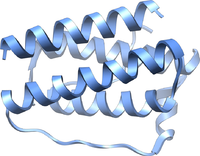
Photo from wikipedia
We explored a computational model of astrocytic energy metabolism and demonstrated the theoretical plausibility that this type of pathway might be capable of coding information about stimuli in addition to… Click to show full abstract
We explored a computational model of astrocytic energy metabolism and demonstrated the theoretical plausibility that this type of pathway might be capable of coding information about stimuli in addition to its known functions in cellular energy and carbon budgets. Simulation results indicate that glycogenolytic glycolysis triggered by activation of adrenergic receptors can capture the intensity and duration features of a neuromodulator waveform and can respond in a dose-dependent manner, including non-linear state changes that are analogous to action potentials. We show how this metabolic pathway can translate information about external stimuli to production profiles of energy-carrying molecules such as lactate with a precision beyond simple signal transduction or non-linear amplification. The results suggest the operation of a metabolic state-machine from the spatially discontiguous yet interdependent metabolite elements. Such metabolic pathways might be well-positioned to code an additional level of salient information about a cell's environmental demands to impact its function. Our hypothesis has implications for the computational power and energy efficiency of the brain.
Journal Title: Journal of theoretical biology
Year Published: 2022
Link to full text (if available)
Share on Social Media: Sign Up to like & get
recommendations!